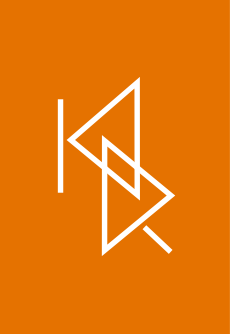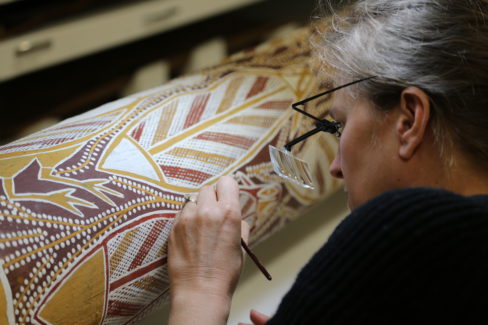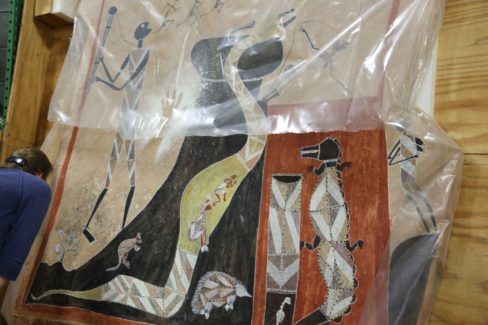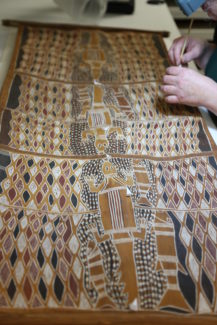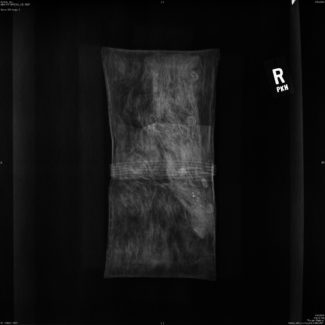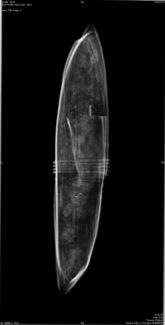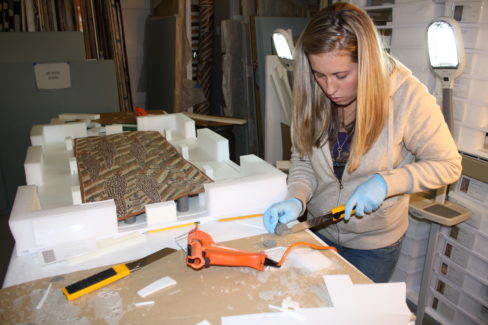What does it take to care for Aboriginal art?
How is caring for Aboriginal art different from caring from any other art? Learn about our eight strategies for good stewardship of Indigenous Australian objects.
Providing Access
Preserving this important collection ensures its continued use by future generations. We want the artworks in our care to remain an active part of the cultures and communities from which they came, rather than objects devoid of context. While most of the objects in the Kluge-Ruhe Collection were made with the intention that they would be sold to non-Indigenous people, they are an expression of cultural knowledge and an extension of the artist’s identity.
It is an institutional priority that whenever possible Indigenous Australians should have access, whether physical or virtual, to the objects in our care. Kluge-Ruhe staff and UVA students are involved in ongoing digitization of the collection and archive to better achieve this goal.
Our curricular role within the University of Virginia makes it vital that our artworks are also accessible to the UVA community and other scholars for object-based learning and research.
We are grateful that part of our art storage facility is located on-site, allowing for tours. Check our calendar for upcoming public tours of the museum’s art storage facilities. Click here to book a private tour.
Innovative Rehousing
We requested and received funding from the Virginia State Council of Higher Education to design, fabricate and install custom storage furniture to rehouse its culturally and historically significant collection of bark paintings from Arnhem Land. Painted with natural pigments on tree bark (Eucalyptus tetrodonta), these inherently unstable artworks make up 30% of the museum’s permanent collection.
Additionally, we recently built custom archival trays and foam mounts to rehouse body adornments, boomerangs, spears, pipes and other small three-dimensional sculptures in the collection.
High Ethical Standards
When visiting artists and traditional knowledge holders visit our site, we observe cultural laws about who has permission to view culturally sensitive artworks. We try to ensure that secret and sacred objects remain out of view unless they are specifically requested by members of that community.
Through careful inventory, we’ve ensured that there are no human remains in the collection, especially for objects that may have been used in a funerary context. When questionable, we undertook non-invasive x-ray procedures at neighboring Martha Jefferson Hospital to ensure no remains were present (see the x-ray images in the slideshow at the top of this page).
We understand that the history of trust between collecting institutions and Indigenous communities has been long, hurtful and problematic. To partake in reconciliation and underscore our commitment to community inclusion and accessibility, we participated in “Makarrata: Bringing the Past into the Future” in Milingimbi, Northern Territory, Australia in 2016. The word makarrata refers to a reconciliation between parties after a dispute. This event was a three-day summit of Yolngu people from northeast Arnhem Land and the museums and art galleries with collections from their communities. Director Margo Smith and intern Sydney Collins (CLAS 2016) represented Kluge-Ruhe as the only American institution present. Click here to read an article about their participation. After in-depth discussions, the attendant institutions signed the Milingimbi Makarrata Resolution, pledging to work together to ensure that the cultural heritage of the people of Milingimbi is managed appropriately in the future.
Becoming a Leader in our Network
Entrusted with 560 bark paintings, Kluge-Ruhe has established itself as a national leader in the appropriate storage, treatment, and exhibition of these objects. In doing so, we have established a network of conservation, museum, and art center professionals in the United States and Australia to collaboratively develop a successful preventive conservation program, remain a key voice in ongoing conversations and maintain awareness of best practices.
Ongoing Stewardship
The Kluge-Ruhe Collection is charged with the stewardship of more than 1900 objects. Unlike many museums, we consider our relationship with the objects as one of custody and not ownership. We recognize that the authorities on every work in the collection are the communities from which they came. This approach informs our decision-making process, from storage to conservation to exhibition.
We have a two-prong approach to conservation. (1) Preventive: Mitigation of deterioration and damage to the permanent collection; and (2) Interventive: Deliberate alteration of an artwork to prolong its existence. As such, we take the following actions as part of preventive conservation:
- develop and implement policies and procedures to ensure appropriate environmental conditions
- limit light exposure
- ensure proper handling of objects
- observe maintenance measures for the storage, transport and display of the artworks
- practice an integrated and comprehensive approach to pest management and risk management
- postpone, reduce, eliminate and increase the longevity of interventive treatment
Conserving 10 – 30 Artworks Each Year
The majority of our interventive treatments involve stabilizing the painted surfaces of bark paintings and sculptures. The bark and wood react to even the slightest changes of relative humidity and temperature, expanding and contracting like breathing lungs. Over time, the fragile paint may lift or detache from the surface. In these instances, interventive conservation treatments at the museum involve a process in which the paint is re-secured to the bark or wood so it does not flake off revealing an area of paint loss. The second-most common conservation treatment is the removal of early Western Desert paintings from acidic frames. When this is done, poplar strainers are glued to the back of the work, allowing it to be hung without the visual encumbrance of a frame. Depending on our exhibition and loan-related needs, the museum treats between 10 and 30 works annually.
Self-Assessment and Peer Review
To proactively align ourselves with best practices established by the American Alliance of Museums (AAM), the Kluge-Ruhe Collection has participated in several programs designed to foster self-assessment and consultative peer-review. In 2009, Kluge-Ruhe participated in AAM’s Museum Assessment Program (MAP), with a focus on Collections Stewardship. Subsequently, in 2011, we participated in AAM’s Conservation Assessment Program (CAP).
Acquiring New Artworks
As a collecting institution, we are actively acquiring works for the permanent collection each year. The collection is stored on-site in three secure, climate-controlled storage spaces and off-site in UVA’s art storage facility that is shared with the Fralin Museum of Art.

